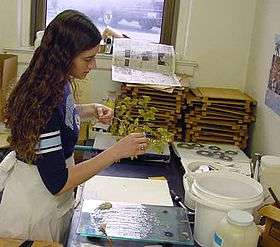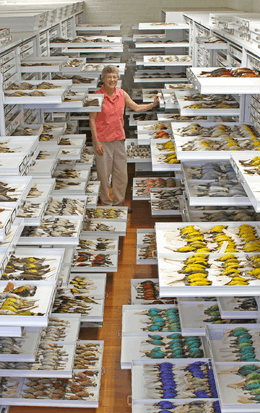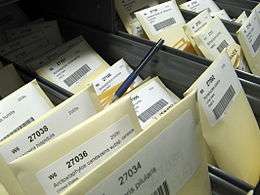Scientific collection



As a scientific collection is referred to
- any systematic collection of objects for the study of nature or of the human history
- as well as the institutions, organizations or sub-organizations that build such collections preserve, develop systematically and make accessible and useful. These institutions often examine the collections also itself.
Important objects of research collections
- in the field of Geology are in particular minerals, rock samples and drilling cores,
- in the field of biology in particular plants, fungi, animals, bacteria, archaea and viruses and their remains,
- in the field of history for example, wood samples with annual rings, pottery and coins not only for the study of these objects themselves, but also e.g. to determine the age of finds during excavations or ice cores and cores of sediments in lakes for the study of climate history .
Important goals of these collections are the items collected for research to make tangible and accessible, hold reference objects for comparison purposes as well as the systematization and naming with scientific names of the collected objects (taxonomy) .
Indexing
The indexing of the collections was historically made by directories, catalogs, index cards, today supplemented by or replaced by databases with information such as e.g. scientific description, including picture, name, location, find circumstances, fund age, scientific analysis, phylogenetic relationships, DNA and isotope analysis results, analysis of pollutants, references, condition of the property, owner changes and name changes.[1]
Many organisations support the indexing and handling of their collections by specialist libraries.
Institutions
Research collections hold especially museums, notably natural history museums, botanical gardens, universities and other research institutions. There are also independent research collections, such as the Zoological State Collection Munich with over 20 million stuffed animals for research purposes. Public authorities such as national geological agencies or police units hold partly research collections too.
The Natural History Museum in London - with one of the biggest collections worldwide - is home to life and earth science specimens comprising some 70 million items within five main collections: botany, entomology, mineralogy, palaeontology and zoology.
Largest German Natural History Museum is the Museum für Naturkunde, Berlin, with over 30 million objects, including 9 million beetles and 275,000 jars with preserved in alcohol animals.[1]
Geology / Earth Sciences collections
Remerkable Earth Sciences collections:
- In Germany the Technische Universität Bergakademie Freiberg has particularly rich geological research collections. This includes 80,000 minerals in the Mineralogical Collection,[2] 120,000 samples from deposits in the deposit collection,[3] 16,000 rocks in the petrological collection,[4] 114,000 macro - and almost a million micro-fossils in the fossil collection,[5] 70,000 macro - and microfossils 12,000 and 15,000 lithostratigraphically or facies relevant rock samples and about 14,000 specimens and sections in the Stratigraphic collection,[6] 30,000 pieces of evidence and 30,000 preparations and cuts in Fuel Geological Collection and 34,000 objects in the central body of evidence Lithothek.[7]
- The IODP/ODP - Kernlager / Bremen Core Repository (BCR) at the University of Bremen has a collection of 140 km of drill core from the Ocean Drilling Program with 190,000 individual pieces, which are stored in a 1.100m ² large cold storage at 4 °C.[8]
- The Musée de Minéralogie a museum of mineralogy operated by the École nationale supérieure des mines de Paris (Mines ParisTech) containing some 100,000 samples including 80,000 minerals, 15,000 rocks, 4,000 ores, 400 meteorites, 700 gems, and 300 artificial minerals.
- The most important geological collections in Europe include the Museum of the Earth of Polish Academy of Sciences in Warsaw With more than 170,000 minerals, meteorites, fossil and a Amber collection.
Biological collections / Life Sciences collections
Typical collection objects biology are fossils of organisms, in particular plants and animals, plants, and animals killed, and be protected from decay, for example, by drying or preparation, but also live plants, animals, bacteria and viruses.
Plant collections are referred to as herbaria. Live plants are collected in the Botanical gardens, (trees ) in arboretums, aquariums, and partly in seedbanks, as well as e.g. algae from the Culture Collection of Algae Göttingen.[9] Live animals are collected in zoos and aquariums. The great Old Botanical Garden of the University of Göttingen e.g. represents about a collection of 17,000 species.[10]
Particularly well known in Germany are the major research collections of the Naturmuseum Senckenberg of Senckenberg Society for Nature Research in Frankfurt am Main with over 22 million natural objects (Herbaria 1 Million). Senckenberg offers to open up his collection to the SESAM database.
The Macaulay Library is the world's largest archive of animal sounds. It includes more than 175,000 audio recordings covering 75 percent of the world's bird species. There are an ever increasing numbers of insect, fish, frog, and mammal recordings. The video archive includes over 50,000 clips, representing over 3,500 species.
An example for a special collection are the objects of the Deutsche Sammlung von Mikroorganismen und Zellkulturen (German Collection of Microorganisms and Cell Cultures).
Remarkable and big Biological collections (more than 1,000,000 specimens) in Europe are
- in France: Muséum National d'Histoire Naturelle, Paris contains 9,500,000 specimens; Université Montpellier contains 4,000,000 specimens; Université Claude Bernard Lyon 1 contains 4,000,000 specimens
- in Russia: Komarov Botanical Institute in St. Petersburg contains 7,160,000 specimens,
- in Great Britain: Royal Botanic Gardens Kew contains 7,000,000 specimens; British Museum of Natural History contains 80,000,000 specimens; Royal Botanic Garden Edinburgh contains 2,000,000 specimens; University of Cambridge contains 1,000,000 specimens; University of Manchester contains 1,000,000 specimens;
- in Switzerland: Conservatoire et Jardin botaniques de la Ville de Genève contains 6,000,000 specimens; Eidgenössische Technische Hochschule Zürich contains 1,500,000 specimens,
- in Austria: Naturhistorisches Museum Wien contains 5,000,000 specimens; Universität Wien contains 1,400,000 specimens,
- in Sweden: Swedish Museum of Natural History (Naturhistoriska riksmuseet) contains 4,400,000 specimens; Uppsala University contains 3,000,000 specimens, Botanical Museum, Lund contains 2,500,000 specimens, Göteborg University contains 1,600,000 specimens,
- in Netherlands: National Herbarium of the Netherlands (Nationaal Herbarium Nederland) contains 4,000,000 specimens
- in Italy: Museo di Storia Naturale dell'Università, Florence contains 3,650,000 specimens; Università degli Studi di Roma La Sapienza, Rome contains 1,120,000 specimens; Università degli Studi di Torino contains 1,000,000 specimens,
- in Belgium: National Botanic Garden of Belgium contains 3,500,000 specimens,
- in Germany: Botanischer Garten und Botanisches Museum Berlin-Dahlem, Zentraleinrichtung der Freien Universität Berlin contains 3,000,000 specimens, University of Jena contains 3,000,000 specimens; Botanische Staatssammlung München contains 2,500,000 specimens; Biozentrum Klein-Flottbek, Hamburg contains 1,400,000 specimens; Staatliches Museum für Naturkunde, Stuttgart contains 1,000,000 specimens
- in Finland: University of Helsinki contains 3,000,000 specimens,
- in Denmark: University of Copenhagen contains 2,510,000 specimens,
- in Norway: Botanical Museum, Oslo contains 1,800,000 specimens,
See more: List of herbaria in Europe
Remarkable and big Biological collections (more than 1,000,000 specimens) in the Americas are:
- in United States: New York Botanical Garden Herbarium contains 7,200,000 specimens; Missouri Botanical Garden Herbarium contains 6,231,000 specimens; Harvard University Herbaria contains 5,005,000 specimens; United States National Herbarium, Washington contains 4,340,000 specimens; Field Museum, Chicago contains 2,650,000 specimens; University and Jepson Herbaria of University of California, Berkeley contains 2,200,000 specimens; California Academy of Sciences Herbarium of California Academy of Sciences contains 1,850,000 specimens; University of Michigan Herbarium, Ann Arbor contains 1,700,000 specimens; Academy of Natural Sciences Herbarium of Academy of Natural Sciences, Philadelphia contains 1,430,000 specimens; Wisconsin State Herbarium of University of Wisconsin-Madison, Madison contains 1,100,000 specimens; Rancho Santa Ana Botanic Garden Herbarium of Rancho Santa Ana Botanic Garden, Claremont contains 1,084,000 specimens; Plant Resources Center of University of Texas at Austin contains 1,006,000 specimens; Botanical Research Institute of Texas, Fort Worth contains 1,000,000 specimens
- in Canada: Agriculture and Agri-Food Canada, Vascular Plant Herbarium contains 1,335,000 specimens,
- in Mexico: Universidad Nacional Autónoma de México, Mexico City contains 1,120,000 specimens.
See more: List of herbaria in North America
Remarkable and big Biological collections worldwide see: List of herbaria
History / Human Heritage collections
Dendrochronology is located on the border between biology and history. An annual ring table or tree-ring calendar is a time series of tree ring s of dendrochronological art tree. Because of the specific growth of each tree species and regional differences of climate, such a table must always refer to a single species from the same region. Important tree chronologies are:
- Hohenheimer Jahrringkalender (Hohenheim tree-ring calendar), complete 12,483 years back to 10,480 BC in the Younger Dryas
- Aegean Dendrochronology Project to 1800 BC, Bronze Age
- Belfast Chronology 5474 BC
- English standard curve to 5,012 BC
- Bristlecone Pine Chronology extends back 8500 years exists for the bristlecone pine in the Southwest US (White Mountains of California)
- Sequoiadendron giganteum Chronology
Remerkable History collections:
- The National Numismatic Collection is the national coin cabinet of the United States. The collection is part of the Smithsonian Institution's National Museum of American History. the collection contains over 1.6 million objects, including 450,000 coins, medals and decorations and 1.1 million pieces of paper money.[11]
- The Norwegian folk music series is a scientific collection of traditional Norwegian dance music.
Literature
See also
References
- 1 2 Die Sammlungen | Deutsche Naturwissenschaftliche Forschungssammlung
- ↑ "Archived copy". Archived from the original on 2013-12-24. Retrieved 2014-01-04.
- ↑ "Archived copy". Archived from the original on 2013-12-24. Retrieved 2014-01-04.
- ↑ "Archived copy". Archived from the original on 2013-12-24. Retrieved 2014-01-04.
- ↑ "Archived copy". Archived from the original on 2013-12-24. Retrieved 2014-01-04.
- ↑ "Archived copy". Archived from the original on 2013-12-24. Retrieved 2014-01-04.
- ↑ "Archived copy". Archived from the original on 2013-12-24. Retrieved 2014-01-04.
- ↑ IODP/ODP - Kernlager / Bremen Core Repository (BCR), Universität Bremen · Universitätssammlungen in Deutschland
- ↑ "Archived copy". Archived from the original on 2012-09-01. Retrieved 2014-01-02.
- ↑ Georg-August-Universität Göttingen - Alter Botanischer Garten
- ↑ "The National Numismatic Collection". Smithsonian Institution. Retrieved October 12, 2011.